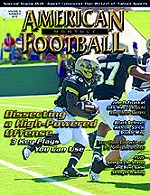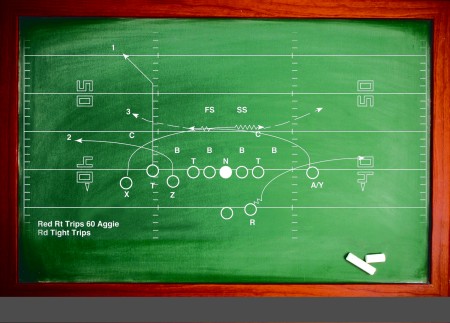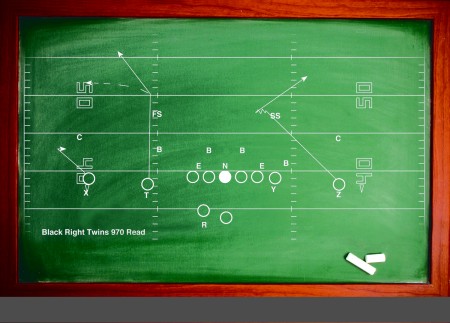Article CategoriesAFM Magazine
|
Dissecting a Successful Offense: Abilene High School (TX)by: David Purdum© More from this issue It takes guts to make changes to an extremely balanced offense that averaged 45 points per game the previous season. Abilene High School (TX) head coach Steve Warren is gutsy. He’s also a state champion, thanks in part to an adjustment to the Eagles’ offense that produced a unique blend of a power running game and the spread offense. “Yep, that characterizes us pretty well,” said Warren, who, in his 14th season, led the Eagles to the 2009 5A Division II state championship. “We’re a spread offense, with a power running game. We’re a spread team by formation; in other words, we are very multiple formation-wise. But we are not a spread team when it comes to the type of plays that we run. Someone asked me at a coaching clinic this offseason what I call our offense. I kind of tagged us a ‘Spread I.’” During last season’s 15-0 championship run in the Texas 5A playoffs, the Eagle offense had nearly a 6-to-1 run-to-pass ratio. They averaged 324 yards rushing compared to 121 yards passing per game and scored 44.6 points per game. In the state championship game, Abilene rushed for 330 yards and scored 28 points on a Katy defense that had surrendered only 10 points per game during the season. The ‘Spread I’ rolled For much of his tenure, Warren and offensive coordinator Del Van Cox have featured a balanced attack, built around pocket passers. In 2008, with Stephen Warren, the coach’s son, under center, the Eagles averaged 197 yards rushing and 197 yards passing. Abilene went 10-1 and averaged 45.6 points per game. After that season, Warren and Cox assessed their personnel and realized they had a new dimension at quarterback. Their string of pocket passers was over. Instead, they now had a 5-8, dual-threat quarterback coming up through the system. A change was needed. Warren and Cox went to work in the off-season. They maintained all of their running game and the majority of their passing game. The change came from the addition of some new spread elements that capitalized on their quarterback’s mobility. The end result was a run-oriented, versatile offense that quickly shifts from a power, two-tight end set to a four-wide spread look. “We think we’re a spread team because we can run some of the spread passing game, but then still keep our tight ends and still have a strong running formation,” Cox explained. “We personnel it, where we have a four-wide or three-wide package or a go with our two-tight package.” Warren keeps personnel packages organized on the sidelines, waiting for Cox to make the call from the press box. “Red is our signal for our four-wide personnel,” Warren said as an example. “We have one coach that signals it into the players on the field, letting them know to get off, while all of our skill positions are standing around me. So when I yell ‘Red,’ they know to get in the game. We haven’t had many problems going from one formation to the other.” The offense starts out of the shotgun 90-95 percent of the time and features normal two-foot splits on the offensive line. It’s centered on mobile quarterback Ronnell Sims and his cousin, star running back Herschel Sims. Warren says the standard counter is their bread and butter and something they’ll run out a lot of different formations. They’ll run zone-read and off-tackle plays, as well. The addition of the four-wide spread look was the biggest change from 2008 to ’09, and it allowed the Eagles to use more sprint-out action with the quarterback. “With the QB we have right now (Sims), we have started running some sprint-out, with the expectation that he would get out to the edge and run it,” said Cox. “We tell him, if he gets the edge, let’s go. So it ends up being a quarterback sweep, but is actually a pass play. We like to get him out there on the edge with the play-action, because he is not very tall, but he’s fast as lightning.” Cox has tried multiple types of protection schemes on his sprint-out package, but this year went back to the “turn-back” protection. “We’re trying to set the edge, so our quarterback has the option to see everything and to run,” Cox added. “We were able to spread him out at receiver a little last season, and it worked out pretty well,” said Warren. “We also will get in our two-back look from time to time in the shotgun, and use (Herschel Sims) as a blocker or motion him to get their attention off the other running back. Our backup running back last year rushed for 1,000 yards.” Controlling the tempo is also an offensive priority, said Warren. The Eagles can huddle one play and jump straight into their “Jet” package to up the tempo on the next play. “Our ‘Jet’ tempo is snapping the ball as soon as the official blows the whistle,” said Warren. In-game Adjustments To start every game, Cox has ten scripted plays designed with the primary objective of seeing how the defense aligns against each formation. The coaching staff will observe how the defense reacts to them then make the proper adjustments to take advantage of the defensive alignment later in the game. “We like to throw a lot of our basic formations at them early so we can get alignments,” Cox said. “In our first 10, 15 plays, we’re trying to see how they’re going to align to our tight-end sets, because, many times these days I think people run the spread just to say they run the spread. They’ll get in the spread and still try to pound the ball. But there are still too many people to block. So a lot of time we see film, and don’t get to see any tight-end alignments. A lot of time we’ll have to be basic in our play-calling to figure out how they’re going to line up against tight-end sets and double-tight sets.” Cox adds that scripting the plays also prepares his players to be ready for the multiple formations so there isn’t as much confusion early in the game. The ‘Foundation’ of Abilene’s Success The first thing Warren did after becoming head coach in 1996 was make sure the program’s feeder system was on the same page in terms of scheme. “From day one, our 7th grade coaches and 8th grade coaches started teaching the same things that we teach up here on both sides of the ball,” said Warren. “That’s the foundation. Any good program is going to do your base stuff, what we call our hat-rack plays. They need to run them throughout the system. That’s something all really good programs have in common.” 60-61 Aggie “This is a pass play we use with crossing action to confuse the defense. The key is to get a high-low read on the corner. In our progression, we try to go corner to flat first. We have some shutdown routes coming in behind it if we don’t get that initial read. This works pretty well against teams that like to play man coverage. We use this play a lot, especially down at the goal line where we get a lot of man coverage and people get lost. Against Cocoa (FL) we completed a two-point conversion to a tight end coming across the middle who hooked and we hit him for the conversion.” • Z receiver: Let T and X clear, then flat route. • RB: check pass protection and release to flat. • T receiver: goes to corner-front pylon if outside 20, back pylon if inside 20. • A/Y receiver: Align 6 yards from tackle and drag at 6 yards. • X receiver: Align 6 yards from tackle and run drag. “This play is a little bit of sprint out, just for protection purposes. With the quarterback we have, we’re trying to get him on the edge with a run-threat option. On the read, we’re just trying to high-low the corner. We’re running a wide stop so the outside linebacker has trouble getting to it, and then, we’re reading the corner. We use this play often, as well, mostly against softer coverage on the corners that try to cover flat routes with their outside linebackers. We ran this play successfully against Plant where our back broke eight tackles and scored.” (See Diagram 2)
“This is a quarterback read play where he can give to the running back or sprint to the left. The key is to get a down block and a kick block that really slows down the inside blitz. We like to run it against defenses that blitz a lot. Teams that blitz a lot get caught up in down blocks and this takes advantage of that. We used it often in the playoffs last year.” (See Diagrams 3A-3D) • RB: aiming point is the A-B gap. • X: stalk/run off corner. • T: stalk outside linebacker. • A/Y: Stalk/run off corner; block ‘under’, if possible; if not, make ‘over’ call. • Z: stalk/run off corner. • TT: down one man and combo to second level. • TG: down one man and combo to second level. • C: pick backside in even front; block big-on-big if in five front. • SG: pull, kick out or log end. • ST: pull around and seal off inside. |
|
| HOME |
MAGAZINE |
SUBSCRIBE | ONLINE COLUMNISTS | COACHING VIDEOS |
Copyright 2024, AmericanFootballMonthly.com
All Rights Reserved







